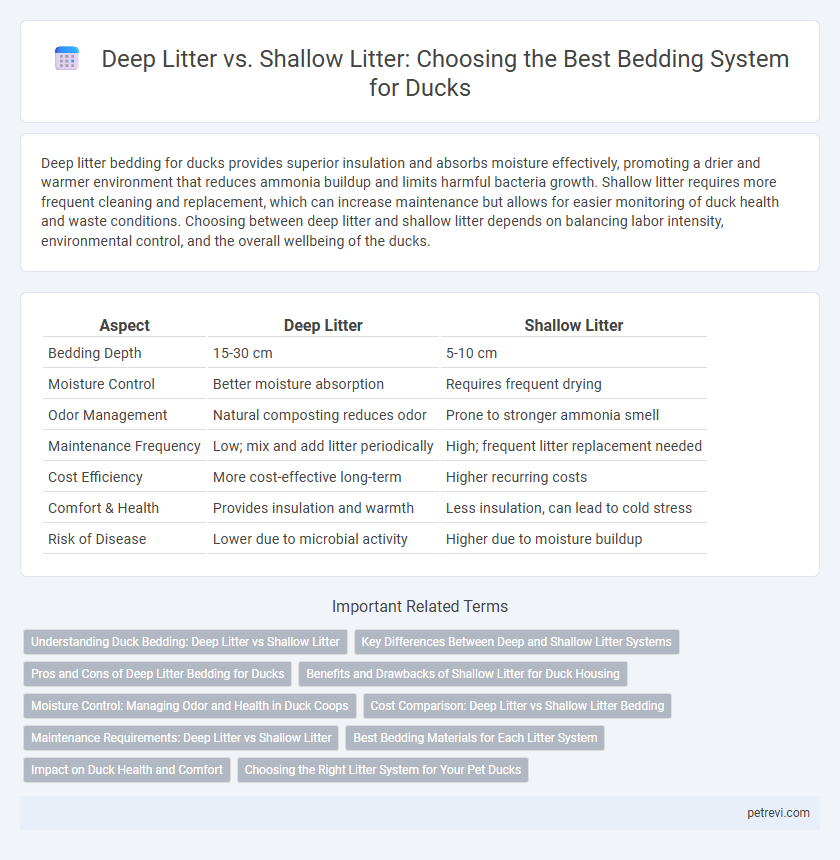Deep litter bedding for ducks provides superior insulation and absorbs moisture effectively, promoting a drier and warmer environment that reduces ammonia buildup and limits harmful bacteria growth. Shallow litter requires more frequent cleaning and replacement, which can increase maintenance but allows for easier monitoring of duck health and waste conditions. Choosing between deep litter and shallow litter depends on balancing labor intensity, environmental control, and the overall wellbeing of the ducks.
Table of Comparison
| Aspect | Deep Litter | Shallow Litter |
|---|---|---|
| Bedding Depth | 15-30 cm | 5-10 cm |
| Moisture Control | Better moisture absorption | Requires frequent drying |
| Odor Management | Natural composting reduces odor | Prone to stronger ammonia smell |
| Maintenance Frequency | Low; mix and add litter periodically | High; frequent litter replacement needed |
| Cost Efficiency | More cost-effective long-term | Higher recurring costs |
| Comfort & Health | Provides insulation and warmth | Less insulation, can lead to cold stress |
| Risk of Disease | Lower due to microbial activity | Higher due to moisture buildup |
Understanding Duck Bedding: Deep Litter vs Shallow Litter
Deep litter systems for duck bedding involve layering organic materials that decompose over time, creating a warm, absorbent environment that supports natural behaviors and reduces ammonia buildup. Shallow litter requires more frequent cleaning and replacement to maintain hygiene but offers easier management and less risk of deep moisture retention. Choosing between deep and shallow litter depends on factors like climate, flock size, and available maintenance resources to optimize duck health and comfort.
Key Differences Between Deep and Shallow Litter Systems
Deep litter systems for duck bedding involve a thick layer of organic material that composts in place, promoting natural warmth and reducing ammonia buildup, while shallow litter systems use a thinner layer that requires frequent replacement to maintain cleanliness. Deep litter provides better insulation and microbial activity, enhancing duck comfort and health, whereas shallow litter offers easier management and quicker drying but less thermal regulation. Choosing between these systems depends on factors like flock size, climate, and maintenance capacity.
Pros and Cons of Deep Litter Bedding for Ducks
Deep litter bedding for ducks offers superior insulation and natural composting benefits, reducing odor and providing a more sustainable waste management system. However, it requires regular maintenance to prevent ammonia buildup and potential health issues, and initial setup can be more labor-intensive than shallow litter. Deep litter is ideal for colder climates where warmth retention is critical but may not be suitable for wet environments due to moisture retention concerns.
Benefits and Drawbacks of Shallow Litter for Duck Housing
Shallow litter in duck housing offers easier cleaning and reduced material costs compared to deep litter systems, promoting better control over moisture and ammonia levels. However, it may require more frequent replacement to prevent odor buildup and pathogen growth, potentially increasing labor demands. Ducks may also experience less natural foraging behavior and comfort due to limited bedding depth.
Moisture Control: Managing Odor and Health in Duck Coops
Deep litter systems for duck bedding excel at moisture control by allowing droppings and bedding to decompose gradually, reducing ammonia buildup and odors that can cause respiratory issues in ducks. Shallow litter requires more frequent cleaning and replacement to prevent excessive moisture accumulation, which can promote bacterial growth and compromise duck health. Effective moisture management in duck coops enhances air quality and supports a healthier environment by minimizing pathogens and unpleasant smells.
Cost Comparison: Deep Litter vs Shallow Litter Bedding
Deep litter bedding for ducks often reduces long-term costs by minimizing the frequency of complete bedding replacements and promoting natural composting that enhances manure management. In contrast, shallow litter requires more frequent cleaning and full replacement, leading to higher labor and material expenses over time. Initial setup for deep litter may be higher, but cost savings in maintenance and waste disposal typically make it more economical than shallow litter systems.
Maintenance Requirements: Deep Litter vs Shallow Litter
Deep litter bedding for ducks requires less frequent complete cleaning due to its composting process, which breaks down waste and reduces odor naturally over time. Shallow litter beds need more frequent replacement and cleaning to prevent moisture buildup and ammonia accumulation, increasing maintenance efforts. Proper ventilation and regular monitoring are essential for both systems to maintain healthy duck living conditions.
Best Bedding Materials for Each Litter System
Deep litter systems for ducks thrive with absorbent materials like straw, wood shavings, or rice hulls that facilitate composting and odor control over time. Shallow litter setups benefit from softer, easily replaceable options such as shredded paper, sand, or dry leaves, ensuring clean and dry conditions. Choosing the right bedding enhances duck health by regulating moisture, reducing ammonia, and providing comfortable resting areas.
Impact on Duck Health and Comfort
Deep litter systems promote better insulation and moisture control, reducing the risk of respiratory infections and footpad dermatitis in ducks. Shallow litter may require more frequent cleaning, increasing stress and exposure to wet, cold conditions that can compromise duck health and comfort. Optimizing litter depth improves ammonia absorption, enhancing air quality and overall welfare in duck housing systems.
Choosing the Right Litter System for Your Pet Ducks
Deep litter systems provide superior insulation and moisture absorption, promoting a healthier environment for pet ducks by reducing ammonia buildup and supporting beneficial microbial activity. Shallow litter systems require more frequent cleaning to prevent dampness and odor, making them ideal for smaller flocks or limited space but less effective in maintaining long-term hygiene. Selecting the right bedding depends on flock size, ventilation, and maintenance capacity, with deep litter favored for larger groups and enhanced composting benefits.
Deep Litter vs Shallow Litter for Duck bedding system Infographic

 petrevi.com
petrevi.com